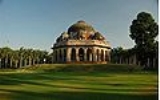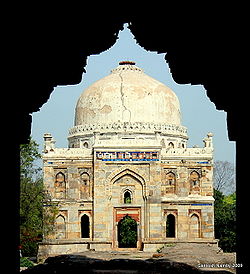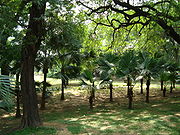
Lodhi Gardens
Encyclopedia

Delhi
Delhi , officially National Capital Territory of Delhi , is the largest metropolis by area and the second-largest by population in India, next to Mumbai. It is the eighth largest metropolis in the world by population with 16,753,265 inhabitants in the Territory at the 2011 Census...
, India
India
India , officially the Republic of India , is a country in South Asia. It is the seventh-largest country by geographical area, the second-most populous country with over 1.2 billion people, and the most populous democracy in the world...
. Spread over 90 acres (364,217.4 m²), it contains, Mohammed Shah's Tomb, Sikander Lodi's Tomb, Sheesh Gumbad and Bara Gumbad, architectural
Architecture
Architecture is both the process and product of planning, designing and construction. Architectural works, in the material form of buildings, are often perceived as cultural and political symbols and as works of art...
works of the 15th century Sayyid
Sayyid dynasty
The Sayyid dynasty ruled Delhi sultanate in India from 1414 to 1451. They succeeded the Tughlaq dynasty and ruled that sultanate until they were displaced by the Lodi dynasty.This family claimed to be Sayyids, or descendants of Prophet Muhammad...
and Lodis, a Pashtun
Pashtun people
Pashtuns or Pathans , also known as ethnic Afghans , are an Eastern Iranic ethnic group with populations primarily between the Hindu Kush mountains in Afghanistan and the Indus River in Pakistan...
dynasty
Dynasty
A dynasty is a sequence of rulers considered members of the same family. Historians traditionally consider many sovereign states' history within a framework of successive dynasties, e.g., China, Ancient Egypt and the Persian Empire...
which ruled much of Northern India during the 16th century, and the site is now protected by the Archeological Survey of India (ASI).
The gardens are situated between Khan Market
Khan Market
Khan Market , named in honour of Khan Abdul Ghaffar Khan , it is the costliest market strip in New Delhi. It has been ranked as the costliest retail location in India...
and Safdarjung's Tomb
Safdarjung's Tomb
Safdarjung's Tomb is a garden tomb with a marble mausoleum in New Delhi, India. It was built in 1754 in the late Mughal Empire style, and was described as "the last flicker in the lamp of Mughal architecture". The top storey of the edifice houses the Archaeological Survey of India...
on Lodi Road. It is beautiful and serene, and is a hotspot for morning walks for the Delhiites.
History

Sayyid dynasty
The Sayyid dynasty ruled Delhi sultanate in India from 1414 to 1451. They succeeded the Tughlaq dynasty and ruled that sultanate until they were displaced by the Lodi dynasty.This family claimed to be Sayyids, or descendants of Prophet Muhammad...
rulers, the earliest of the tombs in the garden, was built in 1444 by Ala-ud-din Alam Shah as a tribute to Mohammed Shah.
As there is little architecture from these two periods remaining in India, Lodi Gardens is an important place of preservation. The tomb of Mohammed Shah is visible from the road, and is the earliest structure in the gardens. The architecture is characterised by the octagonal chamber, with stone chhajja
Chhajja
A chhajja is the projecting or overhanging eaves or cover of a roof, usually supported on large carved brackets. It was used extensively by Hindus for thousands of years, and then more recently borrowed by the invading Muslim empires into the common vocabulary of “Mughal Architecture."It forms...
s on the roof and guldastas on the corners.
Another tomb within the gardens is that of Sikander Lodi, which is similar to Mohammed Shah's tomb, though without the chhatris, it was built by his son Ibrahim Lodi in 1517, the last of Sultan of Delhi from Lodi dynasty, as he was defeated by Babur
Babur
Babur was a Muslim conqueror from Central Asia who, following a series of setbacks, finally succeeded in laying the basis for the Mughal dynasty of South Asia. He was a direct descendant of Timur through his father, and a descendant also of Genghis Khan through his mother...
, First battle of Panipat
First battle of Panipat
The first battle of Panipat took place in Northern India, and marked the beginning of the Mughal Empire. This was one of the earliest battles involving gunpowder firearms and field artillery.-Details:...
in 1526, this laying the foundation of the Mughal Empire
Mughal Empire
The Mughal Empire , or Mogul Empire in traditional English usage, was an imperial power from the Indian Subcontinent. The Mughal emperors were descendants of the Timurids...
. His tomb is often mistaken to be the Sheesh Gumbad, and is actually situated in near the tehsil
Tehsil
A Tehsil or Tahsil/Tahasil , also known as Taluk and Mandal, is an administrative division of some country/countries of South Asia....
office in Panipat
Panipat
Panipat بَنِبَت is an ancient and historic city in Panipat district, Haryana state, India. It is 90 km north from Delhi and 169 km south of Chandigarh on NH-1. The three battles fought at the city were turning points in Indian history. The city is famous in India by the name of "City of...
, close to the Dargah
Dargah
A Dargah is a Sufi shrine built over the grave of a revered religious figure, often a Sufi saint. Local Muslims visit the shrine known as . Dargahs are often associated with Sufi meeting rooms and hostels, known as khanqah...
of Sufi saint Bu Ali Shah Qalandar
Bu Ali Shah Qalandar
Shaikh Sharafuddeen Bu Ali Qalandar Panipati was a Sufi saint of the Chishtī Order who lived in India. His dargah in the town of Panipat is a place of pilgrimage....
. It is a simple rectangular structure on a high platform approached by a flight of steps. The tomb was renovated by the British, and an inscription mentioning Ibrahim Lodi's defeat at the hands of Babur and the renovation was included in 1866.
In the centuries, after the 15th century Sayyid
Sayyid dynasty
The Sayyid dynasty ruled Delhi sultanate in India from 1414 to 1451. They succeeded the Tughlaq dynasty and ruled that sultanate until they were displaced by the Lodi dynasty.This family claimed to be Sayyids, or descendants of Prophet Muhammad...
and Lodi dynasties, two villages grew around the monuments, but the villagers were relocated in 1936 in order to create the gardens. During British Raj
British Raj
British Raj was the British rule in the Indian subcontinent between 1858 and 1947; The term can also refer to the period of dominion...
, it was landscaped by Lady Willingdon
Marie Freeman-Thomas, Marchioness of Willingdon
Marie Freeman-Thomas, Marchioness of Willingdon, GBE CI was born as Marie Adelaide Brassey, a daughter of Thomas Brassey, 1st Earl Brassey....
, wife of Governor-General of India
Governor-General of India
The Governor-General of India was the head of the British administration in India, and later, after Indian independence, the representative of the monarch and de facto head of state. The office was created in 1773, with the title of Governor-General of the Presidency of Fort William...
, Marquess of Willingdon
Freeman Freeman-Thomas, 1st Marquess of Willingdon
Major Freeman Freeman-Thomas, 1st Marquess of Willingdon was a British Liberal politician and administrator who served as Governor General of Canada, the 13th since Canadian Confederation, and as Viceroy and Governor-General of India, the country's 22nd.Freeman-Thomas was born in England and...
, and hence named the 'Lady Willingdon Park' upon its inauguration on April 9, 1936, and 1947, after Independence, it was given its present name, Lodi Gardens.
Later, it was re-landscaped in 1968 by J A Stein, who also designed the adjacent India International Centre
India International Centre
The India International Centre is a well known non-official organization situated in New Delhi, India. It was founded in 1958, and inaugurated in 1968...
, along with Garrett Eckbo
Garrett Eckbo
Garrett Eckbo was an American landscape architect notable for his seminal 1950 book Landscape for Living.-Youth:...
, during the time Stein also made a glass house
Glass House
The Glass House or Johnson house, built in 1949 in New Canaan, Connecticut, was designed by Philip Johnson as his own residence and is a masterpiece in the use of glass. It was an important and influential project for Johnson and for modern architecture. The building is an essay in minimal...
within the park. A British-period gateway, is still being used as an entrance that once welcomed visitors to 'Lady Willingdon Park'.
Overview
In the middle of the gardens is the Bara Gumbad ("Big Dome"), it consists of a large rubble-construct dome, it is not a tomb but a gateway to an attached a three domed masjid (mosqueMosque
A mosque is a place of worship for followers of Islam. The word is likely to have entered the English language through French , from Portuguese , from Spanish , and from Berber , ultimately originating in — . The Arabic word masjid literally means a place of prostration...
), both built in 1494 during the reign of Sikander Lodi, there is also a residence surrounding a central courtyard, where the remains of a water tank can be seen. Opposite the Bara Gumbad is the Sheesh Gumbad ("Glass dome") for the glazed tiles used in its construction, which contains the remains of an unknown family, this was also built during the reign of Sikander Lodi.

Since 2005, INTACH and Archeological Survey of India (ASI
ASI
-Names:* ASI Solutions, an Australian IT company* Asi, a Russian name for the Ossetians* Asi, another name for the Orontes River* Asi language, a language spoken by Bantoanons from the island of Banton, Philippines...
) organize heritage walks for students and general public within the park area, which has become a favorite with morning walkers and yoga enthusiasts. It is also a popular picnic spot for the residents of New Delhi
New Delhi
New Delhi is the capital city of India. It serves as the centre of the Government of India and the Government of the National Capital Territory of Delhi. New Delhi is situated within the metropolis of Delhi. It is one of the nine districts of Delhi Union Territory. The total area of the city is...
. INTACH has made available a small booklet, offering information about park's history, and the monuments, birds and trees within the complex. In 2009, Archaeological Survey of India
Archaeological Survey of India
The Archaeological Survey of India is a department of the Government of India, attached to the Ministry of Culture . The ASI is responsible for archaeological studies and the preservation of archaeological heritage of the country in accordance with the various acts of the Indian Parliament...
(ASI) awarded the restoration project of five monuments with the garden in phases to and INTACH Delhi Chapter, starting with the Bara Gumbad, Shish Gumbad and Mohammed Shah's Tomb, after conservation report for the sites were being prepared since 2007. The MoU of the Rs 1 crore, first phase of the project funded by Steel Authority of India Ltd. (SAIL) was signed in 2005, initiating the process of conservation in which structural work began in 2009.
Further reading
- Sunday at the Lodi Gardens, by Vinay Dharwadker. Published by Viking, 1994.
- Lalkot to Lodi Gardens: (Delhi of Sultans), by Ranjit Sinha. Published by South Asia Books, 1996. ISBN 817167237X.
External links
- Lodi Gardens at wikimapiaWikimapiaWikiMapia is a privately owned, online map and satellite imaging resource that combines Google Maps with a wiki system, allowing users to add information, in the form of a note, to any location on Earth. Users may currently use this information for free...
- Lodi Garden Delhi

